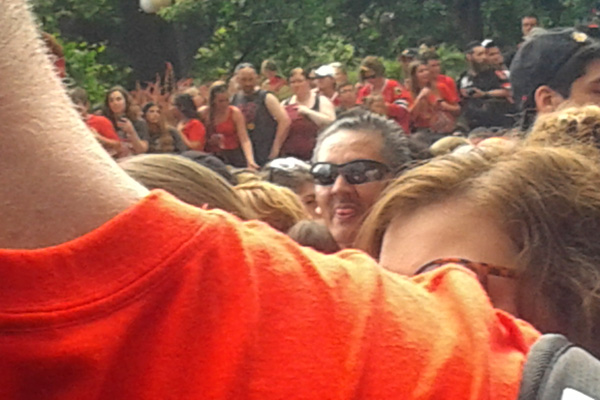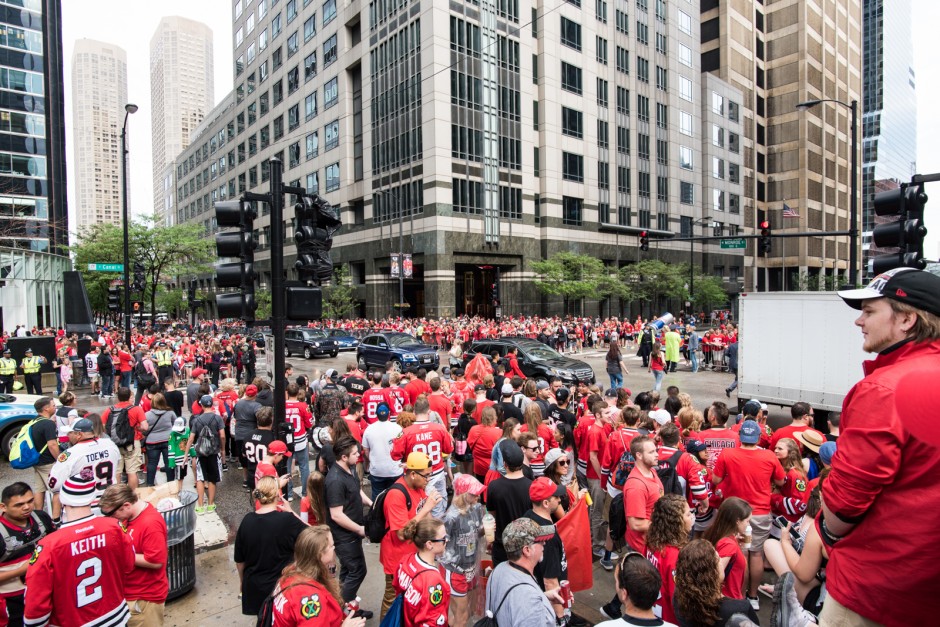On my way to an appointment last Thursday, I got tangled up in the Blackhawks celebration. I was weaving through the crowd around 9:30 a.m. when I found myself hemmed in on all sides by a pulsing wall of sweaty bodies. I was stuck.
I was mashed against the plate-glass window of a Citibank on Michigan Avenue. The drunk girl on my left began to vomit. The crowd had an aggressive vibe. I feared a trampling incident, and the heat and humidity were taking their toll. I was trying to teach deep breathing to a young woman I didn’t know whose shoe was on my foot.
The revolving door of the bank had a tiny little crescent roof. Drunk young people climbed it and bounced up there. They yelled and threw things. It seemed the whole revolving door could topple under their weight.
Suddenly I realized my ATM card would get me into the relative calm of the bank lobby. I swiped and swiped with a desperation that surprised me. On the sixth or seventh try, the light turned green. A miracle. The vomiting drunk girl and the friend taking care of her came in with me.
What happened next was kind of amazing. The people inside the foyer focused on the sick. We made a small, make-shift hospital and I think we saved a few lives. As nasty as the crowd was, our crew inside was proportionately fantastic.
We couldn’t let everyone in who wanted in. Some banged so hard they cracked the glass on the door. But we had a “bouncer” named Jake, a sweet young man with a nice girlfriend, and Jake admitted only those truly in distress. Our space was only the size of a small living room. To keep it from being overwhelmed, Jake would push intruders out, explain that we had sick people inside, and slam the door on them.
Usually by the time someone was begging at the door, they were crying. Several women came in in the midst of panic attacks. One hid under a table, she told me later, because she was afraid her anxiety would make her violent. She was shaking, gasping for breath, and wiping her sweat with a sock.
Our community grew to about 10 people. A pregnant woman; a fasting Muslim man; a dehydrated, elderly homeless man; a child with asthma; and a teen with diabetes. Water was in short supply, but we shared with one another.
A young couple banged on the glass window. There was terror in the woman’s eyes. Jake the bouncer made his way through the wall of human bodies outside and went right to them. The man, her boyfriend, was having a seizure. Jake picked him up and helped them inside our little hospital.

I called 911. The boy continued to seize. Medics pushed their way to us, arriving about 20 minutes after my call. They carried the now-conscious boy out on a stretcher. His girlfriend went with him. They also took the original drunk vomiter, a 17-year-old who appeared to have alcohol poisoning.
My phone was dying, but I conserved its power and called 911 again—for the panic attack woman, for the homeless man. I called so many times that I was beginning to get friendly with the dispatcher.
There was an incredible angel of a woman—just an undergrad—who held the forehead of many. She galvanized our group. She made it through the throng to Walgreen’s and spent her own money on water when the need became dire. She fanned the woman having a panic attack, all the while saying calming words. And she never, ever lost her good cheer. She was so loving and good; I’m not even religious, but I wanted to canonize her right there.
Outside it was hot and humid—and there was no sign of the Blackhawks. The crowd got more agitated. A fist fight erupted. What would we do, I wondered, if the glass shattered and the outside spilled in, engulfing our makeshift hospital in its dangerous, drunken chaos?
A mother and her son begged for entry. Jake let them in. The son was angry, throwing his weight around. Jake patted his shoulder and said, “You know what’s happening? You were in a clusterfuck, and you’re not anymore. You’re safe now.” The boy visibly relaxed. They joined the community too, and I talked with his mother about how the boy suffers from migraines.
I don’t know their names, but I would recognize them on the street, all those people who were in that lobby with me. By the end there were about 20 of them, and their faces are etched in my memory. People can be so good. People can be so kind. People can restore your faith in humankind.
The fear didn’t go away. Even though we were “safe” inside, I knew that the outside could come in, the inside could come out, that I truly could be trampled. I tried to stay calm. For about three minutes I even read my New Yorker, a vestige from a more peaceful time, and the lunacy of that action wasn’t lost on me.
Then, two hours after it began, the siege was over. The buses carrying the Blackhawks and the Stanley Cup came down the street, and the drunk, young fans howled and then finally started to disperse. Our community, our hospital, also scattered. When I finally came out of the ATM lobby, I navigated past—and through—a sheen of vomit all the way to the Van Buren Metra stop, to take the train home to Hyde Park. It was 11:30 a.m., and many revelers were already passed out on the benches.
I never did make my appointment.
The jersey-wearing fans will likely forget their celebration in time, but I will never forget what it felt like to be afraid and trapped or what it felt like to fight back against the fear with community and care.



